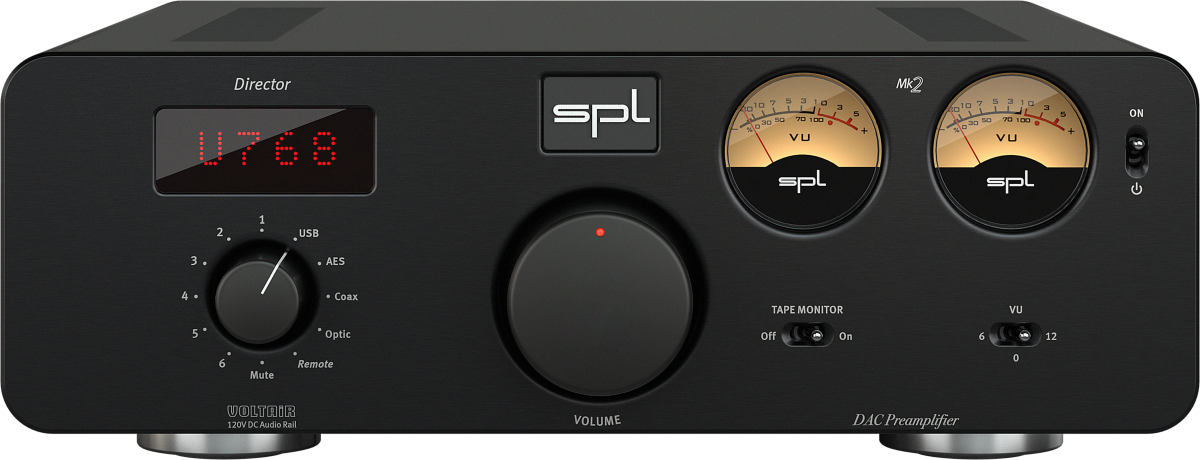Director MK2
DA Converter and Preamplifier
The Director Mk2 is the derivative of SPL reference preamplifier Director:The all new high voltage digital to analog converter now supports 32 bit and sample rates up to 768kHz as well as DSD4.
Fans of analog tape machines or external audio processing can insert their beloved gear in the Tape Monitor loop.
DA Converter and Preamplifier
The Director Mk2 is the derivative of SPL reference preamplifier Director:The all new high voltage digital to analog converter now supports 32 bit and sample rates up to 768kHz as well as DSD4.
Fans of analog tape machines or external audio processing can insert their beloved gear in the Tape Monitor loop.
|
Director MK2
|
Director Mk2 is the heart of the stereo system to which all components are being connected:
Computer, player, phono preamp like the Phonos, headphone amps like the Phonitor xe or the Phonitor e and power amplifiers like the Performer s800 or Performer m1000 or active loudspeakers instead. |
|
Preamplifier
|
Director Mk2 is a full-fledged stereo preamplifier for connecting up to ten stereo input sources.
Six of which are in the analog domain offering two balanced XLR and four RCA stereo inputs. Four inputs are in the digital domain: AES/EBU, USB, COAX, OPTICAL. Power amplifiers or active loudspeakers are connected via balanced XLRs and a headphone amplifier is connected to the Direct Out. |
|
Volume
|
Volume is controlled strictly in the analog domain – for good reason.
Commonly volume is set in the digital domain as part of a DAC chip's functionality. The down side is that the full bit resolution is only present at maximum playback volume. But we never listen with the preamp' volume turned up fully clockwise. As a result we always listen at a lower bit resolution and therefore with a diminished audio fidelity. An average listening level is about 30dB below maximum (0dBfs) and as the resolution shrinks by 1 bit per 6dB level drop the playback will have a 5dB lesser resolution. It makes not a lot of sense to listen to high res audio then, does it? Therefore we opted for an analog solution that gives you full bit resolution at all listening levels. To control the 120V rail VOLTAiR volume stage we use an ALPS RK27 "Big Blue" potentiometer with excellent feeling and channel matching. Being motorized Volume can be remotely controlled. Please refer to the chapter "Remote Control" for more information. |
|
Sources
|
The rotary switch selects the input source, which is then shown in the dot matrix display: IN 1 to IN 6 for the analog inputs and AES/EBU, USB, COAX, OPTICAL for the digital inputs.
The detected sample rate of the selected digital input is displayed after about 2sec. (e.g. U768 = USB input, 768kHz sample rate). The input source selection can also be remotely controlled when the selector is set to "Remote". Please refer to the chapter "Remote Control" for more information. |
|
Optical
|
Type II Optical connections use optical fiber with F05 connectors, which are more commonly known by their Toshiba brand name, TOSLINK. Type II Optical connections are also used in consumer audio and are also called "Optical".
Like AES and Coaxial it supports sample rates up to 192kHz for two coded PCM audio channels. |
|
USB
|
The most interesting input is the USB port for connection with a computer. The Director Mk2 supports both audio formats PCM and DSD. For PCM audio sample rates are supported up to 768kHz and for DSD audio sampling is supported up to DSD4 (quad-rate DSD) also known as DSD256 (256 times the CD sample rate of 44.1kHz).
When connected to a PC the Windows driver must be installed to playback audio files with a higher resolution than 44.1kHz or 48kHz. On a Mac the install of a driver is not needed. Apple natively supports USB class 2 with sample rates up to 768kHz. |
|
DSD over USB
|
SACD or BluRay players typically do not put out the DSD stream for copy protection reasons. This means that an existing SACD/BluRay player can only be connected to the analog inputs of the Director Mk2.
To playback (non-encrypted) DSD files from a computer can only be handled over USB. Specific software players like Audirvana Plus (Mac), Channel D Pure Music (Mac), J River Media Center (Mac/PC), Signalyst (PC), Foobar2000 (PC), JPlay (PC) support DSD playback. The USB audio 2.0 specification defined several formats for the more common PCM approach to digital audio, but did not define a format for DSD. In 2012, representatives from many companies and others developed a standard commonly known as "DSD over PCM", or "DoP" to represent and detect DSD audio within the PCM frames defined in the USB specification |



